Andean condor
| Andean condor Temporal range: 2.6–0 Ma | |
|---|---|
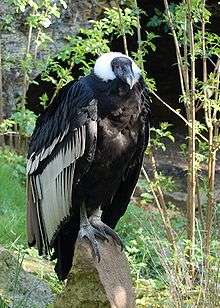 | |
| Female at Doué-la-Fontaine Zoo, France | |
 | |
| Male at the Cincinnati Zoo | |
| Scientific classification | |
| Kingdom: | Animalia |
| Phylum: | Chordata |
| Class: | Aves |
| Order: | Cathartiformes |
| Family: | Cathartidae |
| Genus: | Vultur Linnaeus, 1758 |
| Species: | V. gryphus |
| Binomial name | |
| Vultur gryphus Linnaeus, 1758 | |
 | |
| Yellow – approximate range/distribution | |
| Synonyms | |
The Andean condor (Vultur gryphus) is a South American bird in the New World vulture family Cathartidae and is the only member of the genus Vultur. Found in the Andes mountains and adjacent Pacific coasts of western South America, the Andean condor is the largest flying bird in the world by combined measurement of weight and wingspan. It has a maximum wingspan of 3.3 m (10 ft 10 in)[2] exceeded only by the wingspans of four seabirds and water birds—the roughly 3.5 m (11 ft 6 in) maximum of the wandering albatross, southern royal albatross, great white pelican and Dalmatian pelican.[3]
It is a large black vulture with a ruff of white feathers surrounding the base of the neck and, especially in the male, large white patches on the wings. The head and neck are nearly featherless, and are a dull red color, which may flush and therefore change color in response to the bird's emotional state. In the male, there is a wattle on the neck and a large, dark red comb or caruncle on the crown of the head. Unlike most birds of prey, the male is larger than the female.
The condor is primarily a scavenger, feeding on carrion. It prefers large carcasses, such as those of deer or cattle. It reaches sexual maturity at five or six years of age and nests at elevations of up to 5,000 m (16,000 ft), generally on inaccessible rock ledges. One or two eggs are usually laid. It is one of the world's longest-living birds, with a lifespan of over 70 years in some cases.
The Andean condor is a national symbol of Argentina, Bolivia, Chile, Colombia, Ecuador, and Peru and plays an important role in the folklore and mythology of the Andean regions. The Andean condor is considered near threatened by the IUCN.[1] It is threatened by habitat loss and by secondary poisoning from carcasses killed by hunters. Captive breeding programs have been instituted in several countries.
Taxonomy and systematics
The Andean condor was described by Swedish scientist Carl Linnaeus in 1758 in the tenth edition of his Systema Naturae and retains its original binomial name of Vultur gryphus.[4] The Andean condor is sometimes called the Argentinean condor, Bolivian condor, Chilean condor, Colombian condor, Ecuadorian condor, or Peruvian condor after one of the nations to which it is native. The generic term Vultur is directly taken from the Latin vultur or voltur, which means "vulture".[5] Its specific epithet is derived from a variant of the Greek word γρυπός (grupós, "hook-nosed").[6] The word condor itself is derived from the Quechua kuntur.[7][8]
The exact taxonomic placement of the Andean condor and the remaining six species of New World vultures remains unclear.[9] Though both are similar in appearance and have similar ecological roles, the New World and Old World vultures evolved from different ancestors in different parts of the world and are not closely related. Just how different the two families are is currently under debate, with some earlier authorities suggesting that the New World vultures are more closely related to storks.[10] More recent authorities maintain their overall position in the order Falconiformes along with the Old World vultures[11] or place them in their own order, Cathartiformes.[12] The South American Classification Committee has removed the New World vultures from Ciconiiformes and instead described them as incertae sedis, but notes that a move to Falconiformes or Cathartiformes is possible.[9]
The Andean condor is the only accepted living species of its genus, Vultur.[13] Unlike the California condor (Gymnogyps californianus), which is known from extensive fossil remains and some additional ones of congeners, the fossil record of the Andean condor recovered to date is scant. Presumed Plio-Pleistocene species of South American condors were later recognized to be not different from the present species, although one known only from a few rather small bones found in a Pliocene deposit of Tarija Department, Bolivia, may have been a smaller palaeosubspecies, V. gryphus patruus.[14]
Description
.jpg)
.jpg)
Although it is on average about seven to eight cm shorter from beak to tail than the California condor, the Andean condor is larger in wingspan, which ranges from 270 to 320 cm (8 ft 10 in to 10 ft 6 in).[3] It is also typically heavier, reaching a weight of 11 to 15 kg (24 to 33 lb) for males and 8 to 11 kg (18 to 24 lb) for females.[15] Overall length can range from 100 to 130 cm (3 ft 3 in to 4 ft 3 in).[15] Among standard measurements, the wing chord is 75.7–85.2 cm (29.8–33.5 in), the tail is 33–38 cm (13–15 in) and the tarsus is 11.5–12.5 cm (4.5–4.9 in).[3] Measurements are usually taken from specimens reared in captivity.[3] The mean weight is 11.3 kg (25 lb), with the males averaging about a kilogram more at 12.5 kg (28 lb), the females a kilogram less at 10.1 kg (22 lb). According to a recently published manual of avian body masses, the species possesses the heaviest average weight for any living flying bird or animal, ahead of competitors such as trumpeter swans (Cygnus buccinator) and Dalmatian pelicans (Pelecanus crispus).[16][17] However, another resources claims a mean species body mass of 10.3 kg (23 lb) for the Andean condor.[18] The Andean condor is the largest living land bird capable of flight if measured in terms of average weight and wingspan, although male bustards of the largest species (far more sexually dimorphic in size) can weigh more at maximum.[15][19][20] The mean wingspan is around 283 cm (9 ft 3 in) and the wings have the largest surface area (measured in square centimeters) of any extant bird.[20] Among living bird species, only the great albatrosses and the two largest species of pelican exceed the Andean condor in average and maximal wingspan.[20][21]
The adult plumage is a uniform black, with the exception of a frill of white feathers nearly surrounding the base of the neck and, especially in the male, large patches or bands of white on the wings which do not appear until the completion of the bird's first moulting.[22] The head and neck are red to blackish-red and have few feathers. The head and neck are meticulously kept clean by the bird,[23] and their baldness is an adaptation for hygiene, allowing the skin to be exposed to the sterilizing effects of dehydration and ultraviolet light at high altitudes.[24] The crown of the head is flattened. In the male, the head is crowned with a dark red caruncle or comb, while the skin of his neck lies in folds, forming a wattle.[22] The skin of the head and neck is capable of flushing noticeably in response to emotional state, which serves to communicate between individuals. Juveniles have a grayish-brown general coloration, blackish head and neck skin, and a brown ruff. [25]
The middle toe is greatly elongated, and the hind one is only slightly developed, while the talons of all the toes are comparatively straight and blunt. The feet are thus more adapted to walking, and are of little use as weapons or organs of prehension as in birds of prey and Old World vultures.[26] The beak is hooked, and adapted to tear rotting meat.[27] The irises of the male are brown, while those of the female are deep red.[28] The eyelids lack eyelashes.[29] Contrary to the usual rule for sexual dimorphism among birds of prey,[30] the female is smaller than the male.[31]
Distribution and habitat
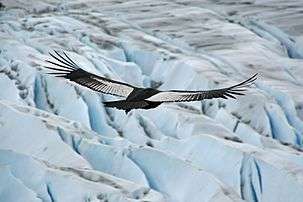
The Andean condor is found in South America in the Andes, including the Santa Marta Mountains. In the north, its range begins in Venezuela and Colombia, where it is extremely rare,[32] then continues south along the Andes in Ecuador, Peru, and Chile, through Bolivia and western Argentina to the Tierra del Fuego.[25] In the early 19th century, the Andean condor bred from western Venezuela to Tierra del Fuego, along the entire chain of the Andes, but its range has been greatly reduced due to human activity.[33] Its habitat is mainly composed of open grasslands and alpine areas up to 5,000 m (16,000 ft) in elevation. It prefers relatively open, non-forested areas which allow it to spot carrion from the air, such as the páramo or rocky, mountainous areas in general.[34] It occasionally ranges to lowlands in eastern Bolivia and southwestern Brazil,[10] descends to lowland desert areas in Chile and Peru, and is found over southern-beech forests in Patagonia.[32]
Ecology and behavior
The condor soars with its wings held horizontally and its primary feathers bent upwards at the tips.[22] The lack of a large sternum to anchor its correspondingly large flight muscles physiologically identifies it as primarily being a soarer. It flaps its wings on rising from the ground, but after attaining a moderate elevation it flaps its wings very rarely, relying on thermals to stay aloft.[35] Charles Darwin commented on having watched them for half an hour without once observing a flap of their wings.[36] It prefers to roost on high places from which it can launch without major wing-flapping effort. Andean condors are often seen soaring near rock cliffs, using the heat thermals to aid them in rising in the air.[37]
Like other New World vultures, the Andean condor has the unusual habit of urohidrosis: it often empties its cloaca onto its legs and feet. A cooling effect through evaporation has been proposed as a reason for this behaviour, but it makes no sense in the cold Andean habitat of the bird.[11] Because of this habit, their legs are often streaked with a white buildup of uric acid.[26]
There is a well-developed social structure within large groups of condors, with competition to determine a 'pecking order' by body language, competitive play behavior, and vocalizations.[38] Generally, mature males tend to be at the top of the pecking order, with post-dispersal immature males tending to be near the bottom.[3]
Diet
The Andean condor is a scavenger, feeding mainly on carrion.[35] Wild condors inhabit large territories, often traveling more than 200 km (120 mi) a day in search of carrion.[24] In inland areas, they prefer large carcasses. Naturally, they feed on the largest carcasses available, which can include llamas (Lama glama), alpacas (Vicugna pacos), rheas (Rhea ssp.), guanacos (Lama guanicoe), deer and armadillos. Wild individuals could acquire extra carotenoids from vegetal matter contained in carcass viscera and fresh vegetation.[39] However, most inland condors now live largely off of domestic animals, which are now more widespread in South America, such as cattle (Bos primigenius taurus), horses (Equus ferus caballus), donkeys (Equus africanus a sinus), mules, sheep (Ovis aries), pigs (Sus scrofa domesticus), goats (Capra aegagrus hircus) and dogs (Canis lupus familiaris). They also feed on the carcasses of introduced game species such as wild boars (Sus scrofa), rabbits (Oryctolagus cuniculus), foxes (Vulpes vulpes) and red deer (Cervus elaphus). For condors who live around the coast, the diet consists mainly of beached carcasses of marine mammals, largely cetaceans.[28][40] They will also raid the nests of smaller birds to feed on the eggs.[41] Andean condors have been observed to do some hunting of small, live animals, such as rodents, birds and rabbits, which (given their lack of powerful, grasping feet or developed hunting technique) they usually kill by jabbing repeatedly with their bill.[40]
Coastal areas provide a constant food supply, and in particularly plentiful areas, some Andean condors limit their foraging area to several kilometers of beach-front land.[33] They locate carrion by spotting it or by following other scavengers, such as corvids or other vultures.[42] It may follow New World vultures of the genus Cathartes—the turkey vulture (C. aura), the lesser yellow-headed vulture (C. burrovianus), and the greater yellow-headed vulture (C. melambrotus)—to carcasses. The Cathartes vultures forage by smell, detecting the scent of ethyl mercaptan, a gas produced by the beginnings of decay in dead animals. These smaller vultures cannot rip through the tougher hides of these larger animals with the efficiency of the larger condor, and their interactions are often an example of mutual dependence between species.[43] Black vultures (Coragyps atratus), king vultures (Sarcoramphus papa) and even mammalian scavengers may sometimes track Cathartes vultures for carcasses but the condor is invariably dominant among the scavengers in its range.[44][45] Andean condors are intermittent eaters in the wild, often going for a few days without eating, then gorging themselves on several pounds at once, sometimes to the point of being unable to lift off the ground. Because its feet and talons are not adapted to grasping, it must feed while on the ground.[24] Like other carrion-feeders, it plays an important role in its ecosystem by disposing of carrion which would otherwise be a breeding ground for disease.[46]
Reproduction
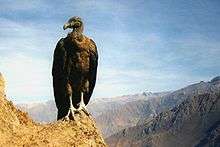

Sexual maturity and breeding behavior do not appear in the Andean condor until the bird is five or six years of age.[47] It may live to 50 years or more, and it mates for life.[48] During courtship displays, the skin of the male's neck flushes, changing from dull red to bright yellow, and inflates.[49] He approaches the female with neck outstretched, revealing the inflated neck and the chest patch, while hissing,[50] then extends his wings and stands erect while clicking his tongue.[28] Other courtship rituals include hissing and clucking while hopping with wings partially spread, and dancing.[24] The Andean condor prefers to roost and breed at elevations of 3,000 to 5,000 m (9,800 to 16,400 ft).[51] Its nest, which consists of a few sticks placed around the eggs, is created on inaccessible ledges of rock. However, in coastal areas of Peru, where there are few cliffs, some nests are simply partially shaded crannies scraped out against boulders on slopes.[33] It deposits one or two bluish-white eggs, weighing about 280 g (9.9 oz) and ranging from 75 to 100 mm (3.0 to 3.9 in) in length, during the months of February and March every second year. The egg hatches after 54 to 58 days of incubation by both parents.[28] If the chick or egg is lost or removed, another egg is laid to take its place. Researchers and breeders take advantage of this behavior to double the reproductive rate by taking the first egg away for hand-rearing, causing the parents to lay a second egg, which they are generally allowed to raise.[52]
The young are covered with a grayish down until they are almost as large as their parents. They are able to fly after six months,[22] but continue to roost and hunt with their parents until age two, when they are displaced by a new clutch.[53] Healthy adults have no natural predators, but large birds of prey and mammalian predators, like foxes, may take eggs or hatchlings. Predation is relatively uncommon, since the vigilant parents often aggressively displace birds of prey who come near and the rocky, precipitous location of most nests are difficult for mammals to access.
Longevity
Being a slowly-maturing bird with no known natural predators in adulthood, an Andean condor is quite a long-lived bird. Longevity and mortality rates are not known to have been extensively studied in the wild. Some estimations of lifespans of wild birds has exceeded 50 years. In 1983, the Guinness Book of World Records considered the longest-lived bird of any species with a confirmed lifespan was an Andean condor that died after surviving 72 years in captivity, having been captured from the wild as a juvenile of undetermined age.[20] Several species of parrot have been reported to live for perhaps over 100 years, but these (at least in 1983) were not considered authenticated.[20] Another early captive-held specimen of condor reportedly lived for 71 years.[20] However, these lifespans have been exceeded by a male, nicknamed "Thaao", that was kept at Beardsley Zoo in Connecticut. Thaao was born in captivity in 1930 and died on January 26, 2010, making him 79 years of age.[54] This would be the greatest verified age ever known for a bird.[20]
Relationship with humans
Conservation status
The Andean condor is considered near threatened by the IUCN.[1] It was first placed on the United States Endangered Species list in 1970,[55] a status which is assigned to an animal that is in danger of extinction throughout all or a significant portion of its range.[56] Threats to its population include loss of habitat needed for foraging, secondary poisoning from animals killed by hunters and persecution.[57] It is threatened mainly in the northern area of its range, and is extremely rare in Venezuela and Colombia, where it has undergone considerable declines in recent years.[58] Because it is adapted to very low mortality and has correspondingly low reproductive rates, it is extremely vulnerable to human persecution,[32] most of which stems from the fact that it is perceived as a threat by farmers due to alleged attacks on livestock.[48] Education programs have been implemented by conservationists to dispel this misconception.[59] Reintroduction programs using captive-bred Andean condors, which release birds hatched in North American zoos into the wild to bolster populations,[59] have been introduced in Argentina, Venezuela, and Colombia. The first captive-bred Andean condors were released into the wild in 1989.[60] When raising condors, human contact is minimal; chicks are fed with glove puppets which resemble adult Andean condors in order to prevent the chicks from imprinting on humans, which would endanger them upon release as they would not be wary of humans.[61] The condors are kept in aviaries for three months prior to release, where they acclimatize to an environment similar to that which they will be released in.[61] Released condors are tracked by satellite in order to observe their movements and to monitor whether they are still alive.[27]
In response to the capture of all the wild individuals of the California condor, in 1988 the US Fish and Wildlife Service began a reintroduction experiment involving the release of captive Andean condors into the wild in California. Only females were released to prevent it becoming an invasive species. The experiment was a success, and all the Andean condors were recaptured and re-released in South America before the reintroduction of the California condors took place.[62]
Role in culture
The Andean condor is a national symbol of Argentina, Bolivia, Chile, Colombia, Ecuador, Peru and Venezuelan Andes states. It is the national bird of Bolivia, Chile, Colombia, and Ecuador.[63] It plays an important role in the folklore and mythology of the South American Andean regions,[48] and has been represented in Andean art from c. 2500 BCE onward,[64] and they are a part of indigenous Andean religions.[65] In Andean mythology, the Andean condor was associated with the sun deity,[66] and was believed to be the ruler of the upper world.[67] The Andean condor is considered a symbol of power and health by many Andean cultures, and it was believed that the bones and organs of the Andean condor possessed medicinal powers, sometimes leading to the hunting and killing of condors to obtain its bones and organs.[27][68] In some versions of Peruvian bullfighting, a condor is tied to the back of a bull, where it pecks at the animal as bullfighters fight it. The condor generally survives and is set free.[69]
In Peru, they are occasionally shot, but more often revered and used for ceremonial purposes. The Yawar Fiesta is a celebration, the pinnacle of which is the tying of an Andean condor to the back of a bull, allowing the condor to kill the bull with its talons before being released. This ceremony is a symbolic representation of the power of the Andean peoples (the condor) over the Spanish (the bull).[70] There is also a ceremony known as the arranque del condor in which a live Andean condor is suspended from a frame and is punched to death by horsemen as they ride by.[71]
The Andean condor is a popular figure on stamps in many countries, appearing on one for Ecuador in 1958, Argentina in 1960, Peru in 1973, Bolivia in 1985, Colombia in 1992, Chile in 2001, and Venezuela in 2004.[72] It has also appeared on the coins and banknotes of Colombia and Chile.[73] The condor is featured in several coats of arms of Andean countries as a symbol of Andes mountains.
The Andean condor is depicted on the logo of Avianca and Aerolineas Argentinas, which are two of the largest airlines in South America.
.png) First Coat of arms of Peru.
First Coat of arms of Peru.

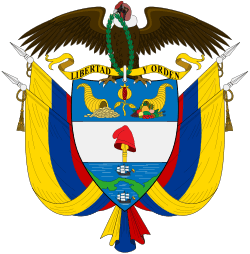
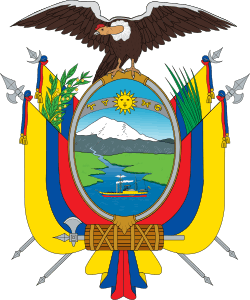
.svg.png)
 Coat of arms of UNAM depicting a condor and golden eagle
Coat of arms of UNAM depicting a condor and golden eagle Hunting for condor. Chile, 19th century.[74]
Hunting for condor. Chile, 19th century.[74] Gauchos lassoing a condor
Gauchos lassoing a condor
(illustration 1895)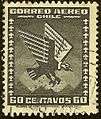 Stamp of Chile, 60 centavos, 1935
Stamp of Chile, 60 centavos, 1935
References
- 1 2 3 BirdLife International (2012). "Vultur gryphus". IUCN Red List of Threatened Species. Version 2013.2. International Union for Conservation of Nature. Retrieved 26 November 2013.
- ↑ Richard P. Reading & Brian Miller 2000.
- 1 2 3 4 5 Ferguson-Lees, James; Christie, David A. (2001). Raptors of the World. Boston: Houghton Mifflin. ISBN 0-618-12762-3.
- ↑ Linnaeus, C (1758). Systema naturae per regna tria naturae, secundum classes, ordines, genera, species, cum characteribus, differentiis, synonymis, locis. Tomus I. Editio decima, reformata. (in Latin). Holmiae (Stockholm): Laurentii Salvii. p. 86.
V. maximus, carúncula verticali longitudine capitis.
- ↑ Simpson, D.P. (1979). Cassell's Latin Dictionary (5th ed.). London: Cassell Ltd. p. 883. ISBN 0-304-52257-0.
- ↑ Liddell, Henry George; Robert Scott (1980). Greek-English Lexicon, Abridged Edition. Oxford: Oxford University Press. ISBN 0-19-910207-4.
- ↑ J. Simpson; E. Weiner, eds. (1989). "Raven". Oxford English Dictionary (2nd ed.). Oxford: Clarendon Press. ISBN 0-19-861186-2.
- ↑ "A Quechua metaphor for a plane: Kuntur-man = "looking like a Condor"". Quechua.org.uk. Retrieved 2010-03-20.
- 1 2 Remsen, J. V., Jr.; Cadena, C. D.; Jaramillo, A.; Nores, M.; Pacheco, J. F.; Robbins, M. B.; Schulenberg, T. S.; Stiles, F. G.; Stotz, D. F. and Zimmer, K. J. (2007). A classification of the bird species of South America. Archived 2009-03-02 at the Wayback Machine. South American Classification Committee. Retrieved on 2007-10-15
- 1 2 Sibley, Charles G. and Monroe, Burt L. (1990). Distribution and Taxonomy of the Birds of the World. Yale University Press. ISBN 0-300-04969-2. Retrieved 2007-04-11.
- 1 2 Sibley, Charles G.; Jon E. Ahlquist (1991). Phylogeny and Classification of Birds: A Study in Molecular Evolution. Yale University Press. ISBN 0-300-04085-7.
- ↑ Ericson, P. G.P; Anderson, C. L; Britton, T.; Elzanowski, A.; Johansson, U. S; Kallersjo, M.; Ohlson, J. I; Parsons, T. J; et al. (2006). "Diversification of Neoaves: Integration of molecular sequence data and fossils". Biology Letters. 2 (4): 543–7. PMC 1834003 . PMID 17148284. doi:10.1098/rsbl.2006.0523.
- ↑ "Vultur gryphus". Integrated Taxonomic Information System. Retrieved 2008-01-13.
- ↑ Fisher, Harvey L. (1944). "The skulls of the Cathartid vultures" (PDF). Condor. 46 (6): 272–296. JSTOR 1364013. doi:10.2307/1364013.
- 1 2 3 del Hoyo, J; Elliot, A; Sargatal, J (1996). Handbook of the Birds of the World. 3. Barcelona: Lynx Edicions. ISBN 84-87334-20-2.
- ↑ CRC Handbook of Avian Body Masses, 2nd Edition by John B. Dunning Jr. (Editor). CRC Press (2008), ISBN 978-1-4200-6444-5.
- ↑ Wallace, M. P., & Temple, S. A. (1987). Competitive interactions within and between species in a guild of avian scavengers. The Auk, 290-295.
- ↑ Atanasov, A. T. (2007). The near to linear allometric relationship between total metabolic energy per life span and body mass of nonpasserine birds. Bulgarian Journal of Veterinary Medicine, 10(4), 235-245.
- ↑ Andean Condor Vultur gryphus. Birdlife International.
- 1 2 3 4 5 6 7 Wood, Gerald (1983). The Guinness Book of Animal Facts and Feats. ISBN 978-0-85112-235-9.
- ↑ Harrison, Peter, Seabirds: An Identification Guide. Houghton Mifflin Harcourt (1991), ISBN 978-0-395-60291-1
- 1 2 3 4 Hilty, Stephen L. (1977). A Guide to the Birds of Colombia. Princeton University Press. p. 88. ISBN 0-691-08372-X.
- ↑ "Behavior of the Andean Condor". Cleveland Metroparks Zoo. Archived from the original on 19 December 2006. Retrieved 2007-01-10.
- 1 2 3 4 Lutz, Dick; Lutz, Richard L. (2002). Patagonia: At the Bottom of the World. DIMI Press. pp. 71–74. ISBN 0-931625-38-6.
- 1 2 Blake, Emmet Reid (1953). Birds of Mexico: A Guide for Field Identification. University of Chicago Press. pp. 262–263. ISBN 0-226-05641-4.
- 1 2 Feduccia, J. Alan (1999). The Origin and Evolution of Birds. Yale University Press. p. 300. ISBN 0-226-05641-4.
- 1 2 3
- 1 2 3 4 Friends of the Zoo. "Andean Condor". Smithsonian National Zoological Park. Archived from the original on 2007-10-09. Retrieved 2008-01-08.
- ↑ Fisher, Harvey L. (1942). "The Pterylosis of the Andean Condor". Condor. 44 (1): 30–32. JSTOR 1364195. doi:10.2307/1364195.
- ↑ Andersson, Malte B. (1994). Sexual selection. Princeton University Press. p. 269. ISBN 978-0-691-00057-2. Retrieved 19 July 2010.
- ↑ Arnold, Caroline; Wallace, Michael Phillip; Wallace, Michael (1993). On the brink of extinction: the California condor. Houghton Mifflin Harcourt. p. 11. ISBN 978-0-15-257990-6. Retrieved 19 July 2010.
- 1 2 3
- 1 2 3 Haemig, PD (2007). "Ecology of Condors". Ecology Online Sweden. Retrieved March 30, 2009.
- ↑ "Habitat of the Andean Condor". Cleveland Metroparks Zoo. Archived from the original on 20 December 2006. Retrieved 2007-01-10.
- 1 2 Wehner, Ross; del Gaudio, Renee; Jankowski, Kazia (2007). Moon Peru. Avalon Travel. p. 180. ISBN 1-56691-983-5.
- ↑ Darwin, Charles (1909). The Voyage of the Beagle. P.F. Collier. p. 201.
- ↑ Benson, Sara; Paul Hellander (2007). Peru. Lonely Planet Publications. p. 53. ISBN 1-74059-749-4.
- ↑ Donazard, José A; Feijoo, Juan E. (2002). "Social structure of Andean Condor roosts: Influence of sex, age, and season". Condor. Cooper Ornithological Society. 104 (1): 832–837. ISSN 0010-5422. doi:10.1650/0010-5422(2002)104[0832:SSOACR]2.0.CO;2. Retrieved 2008-01-10.
- ↑ Blanco, G.; Hornero-Méndez, D.; Lambertucci, S.A.; Donázar, J.A.; Bautista, L.M.; Wiemeyer, G.; Sanchez-Zapata, J.A.; Garrido-Fernández, J.; Hiraldo, F. (2013). "Need and seek for dietary micronutrients: endogenous regulation, external signaling and food sources of carotenoids in New World vultures". PLoS ONE. 6: e65562. PMID 23785435. doi:10.1371/journal.pone.0065562.
- 1 2 ADW: Vultur gryphus: INFORMATION. Animaldiversity.ummz.umich.edu. Retrieved on 2012-12-19.
- ↑ "Andean Condor (Vultur Gryphus)". National Geographic. Retrieved 2007-01-10.
- ↑ Snyder, Noel F. R.; Helen Snyder (2006). Raptors of North America: Natural History and Conservation. Voyageur Press. p. 45. ISBN 0-7603-2582-0.
- ↑ Muller-Schwarze, Dietland (2006). Chemical Ecology of Vertebrates. Cambridge University Press. p. 350. ISBN 0-521-36377-2.
- ↑ Ecology of Condors: the California Condor and Andean Condor. Ecology.info. Retrieved on 2012-12-19.
- ↑ "Ecology of Condors". Archived from the original on 2006-10-01. Retrieved 2006-10-05.. ecology.info.
- ↑ Gomez, Luis G.; Houston, David C.; Cotton, Peter; Tye, Alan (1994). "The role of greater yellow-headed vultures Cathartes melambrotus as scavengers in neotropical forest". Ibis. 136 (2): 193–196. doi:10.1111/j.1474-919X.1994.tb01084.x. Archived from the original on 29 January 2008. Retrieved 2008-01-06.
- ↑ "Andean Condor (Vultur Gryphus)". The Peregrine Fund. Archived from the original on 5 February 2007. Retrieved 2007-01-10.
- 1 2 3
- ↑ Whitson, Martha A; Whitson, Paul D. (1968). "Breeding Behavior of the Andean Condor (Vultur Gryphus)" (PDF). Condor. Cooper Ornithological Society. 71 (1): 73–75. JSTOR 1366056. doi:10.2307/1366056. Retrieved 2007-01-10.
- ↑ Gailey, Janet; Bolwig, Neils (1973). "Observations on the Breeding Behavior of the Andean Condor (Vultur Gryphus)" (PDF). Condor. Cooper Ornithological Society. 75 (1): 60–68. JSTOR 1366535. doi:10.2307/1366535. Retrieved 2007-01-10.
- ↑ Fjeldså, Jon; Krabbe, Niels (1990). Birds of the High Andes. Apollo Books. p. 90. ISBN 87-88757-16-1.
- ↑ National Research Council (1992). Scientific Bases for the Preservation of the Hawaiian Crow. National Academies Press. p. 74. ISBN 0-309-04775-7.
- ↑ Cisneros-Heredia, Diego F. (2006). "Notes on breeding, behaviour and distribution of some birds in Ecuador". Bulletin of the British Ornithologists' Club 126 (2): 153–164 contains a record of a juvenile accompanying an adult male in July, too early to have been of that year's cohort.
- ↑ Zoo Family Mourns Death of Oldest Living Andean Condor in Captivity | Connecticut's Beardsley Zoo Archived May 20, 2012, at the Wayback Machine.. Beardsleyzoo.org (2010-01-26). Retrieved on 2012-12-19.
- ↑
- ↑
- ↑
- ↑
- 1 2
- ↑
- 1 2
- ↑
- ↑
- ↑
- ↑
- ↑
- ↑
- ↑
- ↑
- ↑
- ↑
- ↑
- ↑
- ↑ Atlas de la historia fisica y politica de Chile. [Laminas, Volumen 1]. 1854.
Bibliography
- Richard P. Reading; Brian Miller (2000), "Andean Condor", Endangered Animals: A Reference Guide to Conflicting Issues, Greenwood Publishing Group, p. 16, ISBN 978-03-1330-816-1
External links
| Wikimedia Commons has media related to: |
| Wikispecies has information related to: Vultur gryphus |
- Vulture Territory Facts and Characteristics: Andean condor
- ARKive – images and movies of the Andean condor (Vultur gryphus)
- Video of Peruvian condors
- BirdLife Species Factsheet
- Andean condor
- Andean condor videos on the Internet Bird Collection
- Scientists Work to Repopulate Colombia's Skies with Condors – slideshow by The Los Angeles Times
- Proyecto Conservación Cóndor Andino de Argentina, Organizado por la Fundación Bioandina Argentina.
- Ecology of condors

